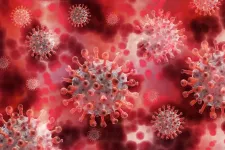Primary lung cancers detected by LDCT are at lower risk of brain metastases
2021-06-24
(Press-News.org) (Denver)-Patients with primary lung cancer detected using low-dose computed tomography screening are at reduced risk of developing brain metastases after diagnosis, according to a study published in the Journal of Thoracic Oncology.
JTO is an official journal of the International Association for the Study of Lung Cancer. The full study is available here: Impact of Low-Dose Computed Tomography Screening for Primary Lung Cancer on Subsequent Risk of Brain Metastasis - Journal of Thoracic Oncology (jto.org)
The researchers, led by Summer Han, PhD, from Stanford University School of Medicine in Palo Alto, Calif., used the National Lung Screening Trial data to identify 1502 participants who were diagnosed with lung cancer between 2002 to 2009 and have follow-up data for brain metastases.
Of 1502 participants, 41.4% had lung cancer detected through LDCT screening versus 58.6% detected through other methods, for example, chest radiograph or incidental detection. Patients whose lung cancer was detected with LDCT screening had a significantly lower three-year incidence of brain metastases (6.5%) versus those without (11.9%), with a cause-specific hazard ratio (HR) of 0.53 (p = 0.001), adjusting for age at lung cancer diagnosis, stage, histology, and smoking status. This significant reduction in brain metastases risk among patients with lung cancer detected through LDCT screening persisted in subgroups of participants with early-stage primary lung cancer (HR = 0.47, p = 0.002) and those who underwent surgery (HR = 0.37, p = 0.001).
To investigate potential explanations for an association between brain metastases risk and lung cancer detected by LDCT screening, the researchers explored LDCT imaging data using a subset of patients (n = 552) who were randomized to the LDCT arm and have LDCT imaging data available. The researchers then compared the characteristics of the nodules that were LDCT screen-detected versus those that were missed by LDCT screening among the patients who were interval detected in the LDCT screening arm.
Given the observed high rate of brain metastases among patients with lung cancer in stage I in NLST (32.4%), the research group further evaluated and compared the characteristics of the nodules of the patients who developed brain metastases (n = 12) versus those who did not develop brain metastases (n = 350) within the patients whose lung cancer was LDCT screen detected in stage I (n = 362).
"This reduction in risk for brain metastases among LDCT screen-detected lung cancer--which persisted in subgroup analyses of patients with early-stage lung cancer and those who underwent surgery for lung cancer--may not be fully explained by stage shift nor curative treatment for PLC," said Han. "The reduction in brain metastases risk may be because of a potentially different tumor biology of the tumors detected by LDCT screening that are less aggressive and slow growing, which needs to be confirmed by further investigation."
"To the best of our knowledge, our study presents the first effort investigating the potential impact of LDCT lung screening on subsequent risk of metastasis," said Han. She pointed out that using the NLST data with a long follow up period provided sufficient time to observe the development of brain metastases.
INFORMATION:
About the IASLC:
The International Association for the Study of Lung Cancer (IASLC) is the only global organization dedicated solely to the study of lung cancer and other thoracic malignancies. Founded in 1974, the association's membership includes nearly 7,500 lung cancer specialists across all disciplines in over 100 countries, forming a global network working together to conquer lung and thoracic cancers worldwide. The association also publishes the Journal of Thoracic Oncology, the primary educational and informational publication for topics relevant to the prevention, detection, diagnosis, and treatment of all thoracic malignancies. Visit http://www.iaslc.org for more information.
About the JTO:
The Journal of Thoracic Oncology (JTO), the official journal of the International Association for the Study of Lung Cancer, is the primary educational and informational publication for topics relevant to the prevention, detection, diagnosis, and treatment of all thoracic malignancies. JTO emphasizes a multidisciplinary approach and includes original research reviews and opinion pieces. The audience includes epidemiologists, medical oncologists, radiation oncologists, thoracic surgeons, pulmonologists, radiologists, pathologists, nuclear medicine physicians, and research scientists with a special interest in thoracic oncology.
[Attachments] See images for this press release:

ELSE PRESS RELEASES FROM THIS DATE:
2021-06-24
A new research paper published in the American Journal of Clinical Nutrition last week showed that a low Omega-3 Index is just as powerful in predicting early death as smoking. This landmark finding is rooted in data pulled and analyzed from the Framingham study, one of the longest running studies in the world.
The Framingham Heart Study provided unique insights into cardiovascular disease (CVD) risk factors and led to the development of the Framingham Risk Score based on eight baseline standard risk factors--age, sex, smoking, hypertension treatment, diabetes status, systolic blood pressure, total cholesterol (TC), and HDL cholesterol.
CVD is still the leading cause of death globally, and risk can be reduced by changing behavioral factors such as unhealthy diet, ...
2021-06-24
A new technique to look at tumors under the microscope has revealed the cellular make-up of Wilm's tumors, a childhood kidney cancer, in unprecedented detail. This new approach could help understand how tumors develop and grow, and fuel research into new treatments for children's cancers.
Scientists at the Princess Máxima Center for pediatric oncology developed a new imaging technique and computational pipeline to study millions of cells in 3D tissue, revealing hundreds of features from each individual cell. Their research was published this month in Nature Biotechnology.
By offering a look at individual cells within an intact organ, the new technique helps scientists analyze the molecular profile of the cells, as well as their ...
2021-06-24
DURHAM, N.C. - The brain's neurons tend to get most of the scientific attention, but a set of cells around them called astrocytes - literally, star-shaped cells - are increasingly being viewed as crucial players in guiding a brain to become properly organized.
Specifically, astrocytes, which form about half the mass of a human brain, seem to guide the formation of synapses, the connections between neurons that are formed and remodeled as we learn and remember.
A new study from Duke and UNC scientists has discovered a crucial protein involved in the communication and coordination between astrocytes as they build synapses. Lacking this molecule, called hepaCAM, astrocytes aren't as sticky as they ...
2021-06-24
GRAND RAPIDS, Mich. (June 24, 2021) -- The same taste-sensing molecule that helps you enjoy a meal from your favorite restaurant may one day lead to improved ways to treat diabetes and other metabolic and immune diseases.
TRPM5 is a specialized protein that is concentrated in the taste buds, where it helps relay messages to and from cells. It has long been of interest to researchers due to its roles in taste perception and blood sugar regulation.
Now, a team led by scientists at Van Andel Institute has published the first-ever high-resolution images of TRPM5, which reveal two areas that may serve as targets for new medications. The structures also may aid in the development of low-calorie alternative sweeteners that mimic sugar. The findings were published today in Nature ...
2021-06-24
BELLINGHAM, Washington, USA - The open access Journal of Astronomical Telescopes, Instruments, and Systems (JATIS) has published END ...
2021-06-24
The study was conducted by an international collaboration involving the research team led by Luca Tiberi of the Armenise-Harvard Laboratory of Brain Cancer at the Department of Cellular, computational and integrative biology - Cibio of UniTrento, the Paris Brain Institute-Institut du Cerveau at Sorbonne Université in Paris, the Hopp Children´s Cancer Center (KiTZ) in Heidelberg, Germany, and Sapienza University in Rome. It was supported by Fondazione Armenise-Harvard, Fondazione Airc (Italian Association for Cancer Research) and Fondazione Caritro from Trento. The findings of the study, published in Science Advances, could lead to better and more effective treatments.
The team of researchers is proud of the results achieved. Luca Tiberi, coordinator of the study and corresponding ...
2021-06-24
Dmitry Blinov is a co-author of the article and Senior Research Associate in the Department of Astrophysics, St Petersburg University. He notes that researchers have been studying the optical polarisation from active galactic nuclei for more than 50 years. Some of the first academic papers on this topic were published back in the 1960s by Vladimir Hagen-Thorn, Professor in the Department of Astrophysics, St Petersburg University, and Viktor Dombrovskiy, Associate Professor in the Department of Astrophysics, Leningrad State University.
In the Universe, the main material is concentrated in galaxies with hundreds of billions of stars: there are about 200-400 of them in the Milky Way. At the centre of galaxies there are supermassive ...
2021-06-24
An international team of researchers co-led by the University of Adelaide and the University of Arizona has analysed the genomes of more than 2,500 modern humans from 26 worldwide populations, to better understand how humans have adapted to historical coronavirus outbreaks.
In a paper published in Current Biology, the researchers used cutting-edge computational methods to uncover genetic traces of adaptation to coronaviruses, the family of viruses responsible for three major outbreaks in the last 20 years, including the ongoing pandemic.
"Modern human genomes contain evolutionary ...
2021-06-24
Rheumatologists are familiar with the everyday use of immunomodulatory drugs. These are designed to treat the inflammation caused by autoimmune diseases such as rheumatoid arthritis. A EULAR taskforce was set up to develop a set of new points to consider to give guidance and advice on the best way to use these medicines to treat COVID-19. The taskforce included rheumatologists, immunologists, haematologists, paediatricians, patients and other health professionals. They looked at the published evidence on the use of immunomodulatory therapies to treat severe COVID-19.
In total, there are two overarching principles and 14 points to consider. The principles stress that the picture of SARS-CoV-2 infection can be very different in different people. Infections range from asymptomatic ...
2021-06-24
Measuring ethane in the atmosphere shows that the amounts of methane going into the atmosphere from oil and gas wells and contributing to greenhouse warming is higher than suggested by the U.S. Environmental Protection Agency, according to an international team of scientists who spent three years flying over three areas of the U.S. during all four seasons.
"Ethane is a gas that is related only to certain sources of methane," said Zachary R. Barkley, researcher in meteorology and atmospheric science, Penn State. "Methane, however, is produced by oil, ...
LAST 30 PRESS RELEASES:
[Press-News.org] Primary lung cancers detected by LDCT are at lower risk of brain metastases




